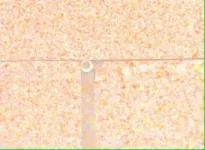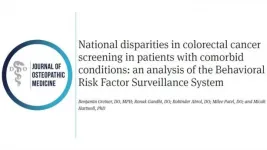(Press-News.org) First-of-its-kind model replicates human alveolar lung tissue
Allows researchers to study effects of COVID-19 on cell growth and development
Provides insight as to how various drugs impact viral spread
Globally, lung failure is one of the leading causes of death. Many conditions can affect and damage the lungs, including asthma, chronic obstructive pulmonary disease, influenza, pneumonia, and, most recently, COVID-19. To better understand respiratory diseases and develop new drugs faster, investigators from Brigham and Women's Hospital designed a 3D "lung-on-a-chip" model of the distal lung and alveolar structures, the tiny air sacs that take in oxygen as you breathe. With this innovation, researchers are actively studying how COVID-19 viral particles travel through airways and impact pulmonary cells. Notably, this technology enables scientists to investigate how various COVID-19 therapies, such as remdesivir, impact the replication of the virus. Their results are published in Proceedings of the National Academy of Sciences.
"We believe that it is a true innovation," said Y. Shrike Zhang, PhD, associate bioengineer in the Brigham's Department of Medicine and Division of Engineering in Medicine. "This is a first-of-its-kind in vitro model of the human lower lung that can be used to test many of the biological mechanisms and therapeutic agents, including anti-viral drugs for COVID-19 research."
Understanding and developing treatments for COVID-19 requires human clinical trials, which are time- and resource-intensive. With better laboratory models, such as the lung-on-a-chip, researchers may be able to evaluate drugs much faster and help select the drug candidates most likely to succeed in clinical trials.
Zhang and colleagues developed this technology to mirror the biological characteristics of the human distal lung. Previous models have been based on flat surfaces and oftentimes made with plastic materials, which do not incorporate the curvature of the alveoli and are much stiffer than the human tissue. Researchers created this new model with materials more representative of human alveolar tissue and stimulated cell growth within these 3D spaces.
In testing the model's effectiveness, researchers found that the 3D alveolar lung effectively grew cells over multiple days and that these cells adequately populated airway surfaces. Through genome sequencing, scientists observed that the alveolar lung model more closely resembled the human distal lung than previous 2D models have. Additionally, the lung-on-a-chip model successfully stimulated breaths of air at the normal frequency for humans.
Beyond COVID-19, Zhang's research team intends to use this technology to study a broad range of pulmonary conditions, including various lung cancers. To replicate smoking's impact on the lungs, scientists allowed smoke to seep into the model's air chambers then simulated a breathing event, moving smoke deeper into the lungs. From there, they measured the smoke's impact and cell damage it caused.
While this innovation holds the potential to vastly expand the possibilities of studying and treating pulmonary diseases, this model is still in its early stages, said Zhang. Currently, the alveolar lung-on-a-chip only incorporates two out of the 42 cell types existing in the lung. In the future, researchers hope to incorporate more cell types into the model to make it more clinically representative of human lungs.
Going forward, Zhang also hopes to study how COVID-19 variants may travel through airways and impact pulmonary cells and COVID-19 therapies. He believes that using this model in tandem with other 3D organs, such as the intestines, could enable researchers to study how oral drugs impact cells in the lower lungs. Zhang also hopes that in the future, this technology could be implemented to urgently understand and develop treatments for emerging contagious diseases.
"In terms of COVID-19, we've had very minimal timelines for developing therapies. In the future, if we have these models ready in hand, we can easily use them to study and test therapeutics in urgent situations where clinical trials are limited," said Zhang.
INFORMATION:
Funding for this work was primarily provided by the Brigham Research Institute, the New England Anti-Vivisection Society, the American Fund for Alternatives to Animal Research (AFAAR), and the European Union's Horizon2020 research and innovation program under grant agreement 760921 (PANBioRA). The lead authors were further supported by funds from their home institutions/countries.
Paper cited: Zhang, YS et al. "Reversed-engineered human alveolar lung-on-a-chip model" Proceedings of the National Academy of Sciences USA DOI: /10.1073/pnas.2016146118
CHAMPAIGN, Ill. --A new study found overlooked tsunami hazards related to undersea, near-shore strike-slip faults, especially for coastal cities adjacent to faults that traverse inland bays. Several areas around the world may fall into this category, including the San Francisco Bay area, Izmit Bay in Turkey and the Gulf of Al-Aqaba in Egypt.
The study led by University of Illinois Urbana-Champaign civil and environmental engineering professor Ahmed Elbanna and professor Ares Rosakis of the California Institute of Technology used the Blue Waters supercomputer at the National Center for Supercomputing Applications to model ...
ALBUQUERQUE, N.M. -- Sometime between 50,000 and 70,000 years ago, prehistoric humans took their first steps into Sahul, an ancient landmass made up of modern Australia, New Guinea and Tasmania. But nobody knows which way they went after that.
"One of the really big unanswered questions of prehistory is how Australia was populated in the distant past. Scholars have debated it for at least 150 years," said Sandia National Laboratories archaeologist and remote sensing scientist Devin White.
Now, an international team of scientists using a Sandia supercomputer in the largest reconstruction ...
Palo Alto, CA--New work from a Stanford University-led team of researchers including Carnegie's Arthur Grossman and Tingting Xiang unravels a longstanding mystery about the relationship between form and function in the genetic material of a diverse group of algae called dinoflagellates.
Their findings, published in Nature Genetics, have implications for understanding genomic organizational principles of all organisms.
Dinoflagellates include more than 2,000 species of marine and freshwater plankton, many of which are photosynthetic, and some of which also ingest other organisms ...
MADISON -- From radio to television to the internet, telecommunications transmissions are simply information carried on light waves and converted to electrical signals.
Silicon-based fiber optics are currently the best structures for high-speed, long distance transmissions, but graphene -- an all-carbon, ultra-thin and adaptable material -- could improve performance even more.
In a study published April 16 in ACS Photonics, University of Wisconsin-Madison researchers fabricated graphene into the smallest ribbon structures to date using a method that makes scaling-up simple. In tests with these tiny ribbons, ...
SEATTLE--A new study of hospital deaths in the United States, published today in JAMA Network Open, is the most comprehensive look yet at changes in hospital mortality during the pandemic. Researchers analyzed data on more than 20,000 patients admitted to hospitals for COVID-19, over nine full months, from March to November of 2020. They found that rates of in-hospital mortality among COVID patients fell 38% between March and May, but there was little further decline through November 2020.
The researchers aimed to uncover the most likely cause of the ...
People have become accustomed to having their temperature checked during the pandemic because fever is a key indicator of COVID-19.
A new commentary by Washington State University College of Nursing Associate Professor Catherine Van Son and Clinical Assistant Professor Deborah Eti proposes that taking a temperature is a less useful indicator of infection in older adults and that a pulse oximeter be used instead.
The paper, published in Frontiers in Medicine, said baseline temperatures are lower in older adults. A lower baseline temperature means a fever may ...
Buildings - The mirage effect
A team of researchers at Oak Ridge National Laboratory has developed a method to detect and measure air leaking from a building's walls and roof that is quicker, cheaper and less disruptive to occupants.
Current air leak detection options, such as using a blower door and smoke or infrared thermography, are costly and invasive. ORNL's method is conducted from outside, using an imaging technique to visualize the flow of air leaks and calculate the volumetric flow of air based on the refraction effects imaged by cameras.
"Similar to a mirage over a black top road in the middle of summer, which looks fuzzy because ...
BURLINGTON, VT -- In the aftermath of George Floyd's 2020 murder by former police officer Derek Chauvin, many families may find themselves actively engaging in--or uncomfortably fumbling around--discussions about race. For white parents looking to clearly communicate antiracist ideologies with their preadolescent children, a new study offers some insight.
"There's a difference between saying race "shouldn't" matter and race "doesn't" matter," explains Jamie Abaied, professor of developmental psychology at the University of Vermont and lead author of the study, ...
CHICAGO--May 3, 2021-- Patients with one or more health conditions are more likely to be screened for colorectal cancer than those without comorbidities, according to new research in the Journal of Osteopathic Medicine. However, patients with five or more health conditions are also less likely to be screened than patients with two to four health conditions.
Colorectal cancer is the second leading cause of cancer death in the U.S. resulting in more than 53,000 deaths each year. Regular colorectal screenings, whether colonoscopy or at-home stool test, ...
Chestnut Hill, MA (5/3/2021) -- The billion-year-old fossil of an organism, exquisitely preserved in the Scottish Highlands, reveals features of multicellularity nearly 400 million years before the biological trait emerged in the first animals, according to a new report in the journal Current Biology by an international team of researchers, including Boston College paleobotanist Paul K. Strother.
The discovery could be the "missing link" in the evolution of animals, according to the team, which included scientists from the U.S., United Kingdom, and Australia. The microfossil, discovered at Loch Torridon, contains two distinct cell types and could be the earliest example of complex multicellularity ...



